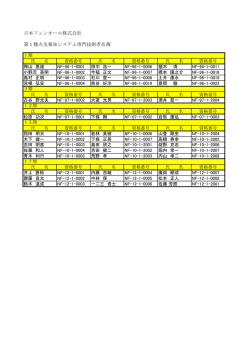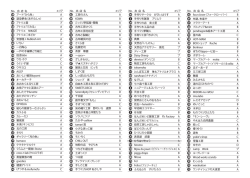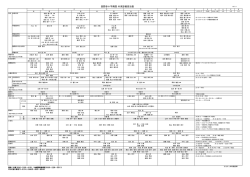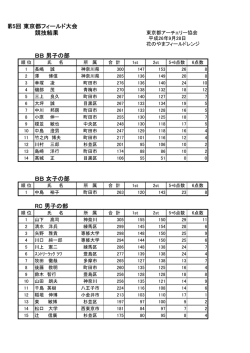
Renkei Hashimoto Hi fu mi
Renkei Hashimoto Hi fu mi Einladung zur Subskription der CD »Hi fu mi« von Renkei Hashimoto Hi fu mi (eins, zwei, drei) — so lautet der Name einer Flötenmelodie, die von japanischen buddhistischen Bettelmönchen zum Ordnen des Atems gespielt wurde. Eigentlich ist es nicht wirklich eine Melodie, es ist eher ein erstes Ausloten der Grundtöne, die durch den Atem im Bambusrohr entstehen. Renkei Hashimoto invites you to subscribe to her CD ”Hi fu mi” Hi fu mi (one, two, three) — this is the name of a flute melody which was played by Japanese Buddhist mendicant monks in order to regulate their breath. Strictly speaking, it is not really a melody but rather a first exploring of basic notes which come into existence through the breath inside the bamboo pipe. Renkei Hashimoto bringt Shakuhachi-Stücke zu Gehör, die mehr meditative Übung als gespielte Musikstücke sind. Von zentraler Bedeutung ist der Atem: Er reguliert die Töne und die Töne regulieren ihn. Das Resultat ist ein faszinierender Klangfarbenreichtum. Das ausführliche CD-booklet enthält ein Interview mit Renkei Hashimoto sowie eine Einführung in die wechselvolle Geschichte der japanischen Bambusflöte und ihre Spieltechnik (von Ingrid Fritsch / Universität Köln). Renkei Hashimoto, geboren 1955, hat in Tokyo und München Gesang studiert. 1998 entdeckte sie in München für sich wieder den Klang der Shakuhachi, eine Bambusflöte aus ihrer Heimat. Seitdem praktiziert sie Komusō (Mönche der Leere) Zen-Shakuhachi in der traditionell überlieferten Form, das zum richtigen Ein- und Ausatmen führt. 2008 erhielt sie die Initiation Kaiden menjo in die Fuke-Shakuhachi nach der Itchōken Linie. Sie lebt und lehrt in der Nähe von München. Die CD erscheint im Winter 2014 im Pagma Verlag zum Preis von 18,50 EUR. Eine öffentliche Vorstellung mit Konzert ist geplant. Die Subskription zum Preis von 15,00 EUR beginnt im Oktober. Zur Registrierung und für weitere Informationen wenden Sie sich bitte an: [email protected] 一 二 三 本手調子 Honte Choshi 本手調子 Honte 本手調子 Honte Choshi Choshi 本手調子 Honte Choshi 本手調子 Honte 一二三 HifumiChoshi 本手調子 Honte Choshi 本手調子 Honte Choshi 一二三 Hifumi 本手調子 Honte 一二三 Hifumi chōshiChoshi 本手調子 Honte Honte Choshi 一二三 一二三 一二三 鉢返し 一二三 鉢返し 一二三 鉢返し 一二三 本手調子 鉢返し 鉢返し 鉢返し 大和調子 鉢返し 大和調子 鉢返し 大和調子 鉢返し 一二三 大和調子 大和調子 大和調子 九州鈴慕 大和調子 九州鈴慕 大和調子 九州鈴慕 大和調子 鉢返し 九州鈴慕 九州鈴慕 九州鈴慕 三谷 九州鈴慕 三谷 九州鈴慕 三谷 九州鈴慕 大和調子 三谷 三谷 三谷 紫野鈴慕 三谷 紫野鈴慕 三谷 紫野鈴慕 三谷 九州鈴慕 紫野鈴慕 紫野鈴慕 紫野鈴慕 奥州さし 紫野鈴慕 奥州さし 紫野鈴慕 奥州さし 紫野鈴慕 三谷 奥州さし 奥州さし 奥州さし 蓮の涙 奥州さし 蓮の涙 奥州さし 蓮の涙 奥州さし 紫野鈴慕 蓮の涙 蓮の涙 蓮の涙 手向け 蓮の涙 手向け 蓮の涙 手向け 蓮の涙 奥州さし 手向け 手向け 手向け 手向け 手向け 手向け 蓮の涙 Renkei Hashimoto performs Shakuhachi pieces which are meditative exercises rather than strict musical compositions. The breath is particularly important: the breath regulates the tones whilst at the Hifumi same time the tones regulate the breath. This results in a fascinaHifumi Hifumi Hachigaeshi Hifumi Hachigaeshi ting richness of tone colours. The detailed CD booklet includes an Hi fuHifumi mi Hachigaeshi Hifumi Honte Choshi Hachigaeshi interview with Renkei Hashimoto as well as an introduction to the Hachigaeshi Hachigaeshi Yamato Choshi Choshi history of the Japanese bamboo flute and its playing techniques Hachigaeshi Hachigaeshi Yamato Hachigaeshi Yamato Choshi Hachigaeshi Hifumi Yamato Choshi (by Ingrid Fritsch / University of Cologne). Yamato Choshi Yamato chōshi Yamato Choshi Kyushu Reibo Yamato Choshi Kyushu Reibo Yamato Choshi Kyushu Reibo Renkei Hashimoto, born in 1955, has studied voice in Tokyo and Yamato Choshi Hachigaeshi Kyushu Reibo Kyushu Kyūshū reibo Reibo Munich. In Munich in 1998 she rediscovered the sound of the Kyushu Reibo Sanya Kyushu Reibo Sanya Kyushu Reibo Sanya Kyushu Choshi Reibo Shakuhachi, a bamboo flute from her native land. She has since Yamato San’ya Sanya Sanya Sanya Murasakino Reibo practiced the playing style of the Komusō (a group of mendicant Sanya Murasakino Reibo Sanya Murasakino Reibo Sanya reibo Reibo Kyushu Murasakino monks) of Zen Shakuhachi in the traditional prescribed form with Murasakino Reibo Murasakino Reibo Murasakino Reibo Oshusashi the correct art of inhaling and exhaling. In 2008 she was initiated Murasakino Reibo Reibo Murasakino ŌshūOshusashi sashi Reibo Oshusashi Murasakino Sanya into the Kaiden rank of the Fuke Shakuhachi according to the ItOshusashi Oshusashi Oshusashi Hasu no Namida Namida chōken. She lives and teaches near Munich. Oshusashi no HasuHasu no namida Oshusashi Hasu no Namida Oshusashi Murasakino Reibo Hasu no Hasu no Namida Namida Hasu no Tamuke Tamuke The CD will be released in the winter of 2014 by the Pagma Verlag for the price Hasu no Namida Namida Tamuke Hasu Tamuke Hasu no no Namida Namida of 18.50 EUR. A public presentation with a concert is in the planning. The subOshusashi Tamuke Tamuke scription price of 15.00 EUR is available in October. To register and to receive Tamuke Tamuke Tamuke further information, please apply to: [email protected] Tamuke Hasu no Namida Pagma Verlag • Klaus-Dieter Eichler • LC-20652 • Postfach 620149 • D–90224 Nürnberg • FaxTamuke +49 – 911 – 627 06 85 • www.pagma-verlag.de • Foto © Gerhard Schielein / Königsdorf 手向け
© Copyright 2025



